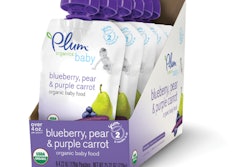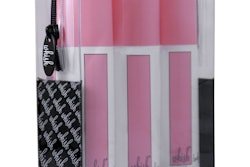LIV president Nancy Dince says that LIV embraced the opportunity to be the first to use the new Groovy bottle from Amcor because it offers a more sustainable option for hot-fill beverages in PET. “The whole culture of LIV Organic is very much based around a concern for the environment and concern for health-related issues on a broad spectrum,” she says. “So when our co-packer mentioned they were in conversations about a bottle with less plastic, we were thrilled.”
After two trial runs of the new bottle at its facility in New Kensington, PA, Castle Co-Packers LLC completed the first production run of LIV Organic in the Groovy bottle in late May with resounding success. Castle president and owner Brian Dworkin says he is proud to have bragging rights as being the first to employ the technology as it allows smaller beverage companies to take advantage of a premium bottle technology at a more affordable price. And, because minimal packaging-line changeparts are required to implement the technology, “it doesn’t send a co-packer to the poorhouse,” he adds.
Resin reduction drives LIV decision
The first user of Groovy, LIV is perfectly poised to take advantage of the marketing and cost benefits of the new technology. The homegrown company was launched in 2006 by sports enthusiast and mom Nancy Dince. “A few years ago I noticed that there was a gap in the marketplace that was important to me personally as an athlete, and as a mother of an athlete,” she recalls. “The gap that I noticed is that there was no really, truly healthy sports drink.”
On one end of the spectrum, she says, were drinks that though healthy, lacked the right formulation of carbohydrates and minerals for recovery and hydration. On the other end were drinks that were optimized in terms of carbs and minerals, but included artificial sweeteners, dyes, and flavors. Dince’s response was to develop a beverage under the LIV Natural name in four flavors derived from organic, unprocessed ingredients such as fruit juices and sweetened with agave nectar.
A year and a half after its launch, the beverage received USDA organic certification and was renamed LIV Organic. In early 2009, as LIV was preparing to change the brand’s label graphics, Dince was approached by LIV’s co-packer and part-investor, Castle, with the opportunity to switch to the new, lighter-weight Groovy bottle.
“Our product is hot-filled,” explains Dince, “so our packaging options were very limited. You can’t really put a sports drink in a glass bottle, because kids need to be able to throw the drink into a soccer bag or into a bike basket, and there really wasn’t anything in the PET environment that offered any sustainability benefits until the Groovy bottle came along. So for us the appeal was that we want to put our money where our mouth is; we want to say to our customers that we are doing everything we can.
“It’s a difficult environment for everybody in terms of sustainability issues. There is more we could all be doing, but it’s nice to be able to say that we are doing everything we can to deliver a product that works for the consumer. The package has to be plastic, so that it has the utility that I referenced before. It has to be hot-filled, so that it doesn’t represent a health issue to consumers. But at least this lighter-weight bottle is one step in the right direction on sustainability.” Using the Groovy finish, the total weight of LIV’s 16.9-oz bottle has been reduced 14.6%, from 36.8 g to 31.4 g.
Grooves replace threads in a ‘mirror image’
Amcor patented the Groovy finish technology in 2006. As Jeff DiLiberty, Amcor’s director of custom business development, explains, in the four years since, the company has worked to refine the design to ensure that the bottle can be seamlessly manufactured and handled at Amcor’s facility, as well as be easily adapted within the packaging environment. “Any time you change finishes on a bottle, you tend to jeopardize the existing infrastructure of both the bottle makers and the fillers because you are changing some of the dimensions of the equipment that needs to touch the bottle,” he says.
Groovy technology revolves around the use of a reduced-thickness finish for the industry-standard 38-mm beverage bottle. “What is particular about Groovy is that the inside diameter of the container is the same as the inside diameter of a standard-finish 38-mm bottle,” explains DiLiberty. “We reduced the outside thickness of the finish by removing the threads and replacing them with grooves. So it’s like a mirror image of a standard-finish bottle.
“That requires the cap to be made with the exact same dimensions as a standard cap, except it is now 37 millimeters in diameter as opposed to 38.” Amcor also reduced the height of the finish, taking out more material.
The end result is 31% less PET in the finish area, and 20% to 25% less resin in the cap. Meanwhile, DiLiberty adds, the drinking experience remains the same for the consumer.
Because the 38-mm bottle makes up about 75% of the 13 billion hot-fill containers produced in North America annually, the resin-saving potential through Groovy is tremendous, DiLiberty says.
Capping off the Groovy design
Bringing the Groovy bottle to market was a joint effort between Amcor, cap supplier Bericap, and Castle. Although the Groovy bottle was designed to accommodate any standard closure, Bericap worked with Amcor, DiLiberty says, “to really refine the details of the Groovy finish.”
The Bericap closure for LIV Organic uses the company’s DoubleSeal™ technology. DoubleSeal eliminates the liner traditionally found in two-piece hot-fill polypropylene caps, using a single-piece construction of high-density polyethylene with a built-in sealing mechanism instead. Explains Bericap president Dave Andison, “Instead of embedding the top of the bottle into the closure as with standard liner caps, what we are really doing is putting two seals on either side of the bottle finish, almost like windshield wipers.”
The advantages to this construction are that less torque is needed to affix the cap onto the bottle, resulting in easier opening for the consumer, as well. In addition, it reduces the ovalization of the bottle finish that is associated with torquing standard caps onto a hot bottle, eliminating resulting leakers.
Andison says that Bericap’s design facility in Germany worked with Amcor to develop a closure “that would mesh with the finish lines of the Groovy bottle.” Prototype tooling for the closure was then built in North America, and lab tests were conducted by Amcor on the resulting closures. “Once we were confident in the closure,” says Andison, “we went to Castle about a year ago and supported the filling line trials.”
Castle Co-Packers, a relative newcomer that has grown from one filling line to five since it opened in 2005 by nurturing startup beverage companies and “nichey products,” as president Dworkin explains, became involved with the Groovy bottle in 2008. “Innovation is first and foremost in this company,” explains Dworkin. “We always want to be on the cutting edge of technology.”
Under an agreement between Amcor and Castle, Amcor agreed to pay for the equipment changeparts that would be required to run the new bottle, while Castle provided the line time at no charge. In exchange, Castle was guaranteed first crack at commercial use of the Groovy technology.
As Dworkin says, Groovy is a “very friendly new technology.” The only changeparts required were those for Castle’s 12-head Zalkin capper. The unique design and supple nature of the DoubleSeal closure also makes capper adjustments very easy, he adds.
An affordable technology
In addition to the Groovy finish and the DoubleSeal cap, the LIV bottle also incorporates one last technology that adds to the bottle’s aesthetics: Amcor’s PowerFlex™. The PowerFlex PET bottle for hot-fill beverages is a panel-less, ribless design that mimics the appearance of glass and allows for greater labeling options. According to Dworkin, the Groovy finish combined with the PowerFlex design will allow smaller beverage companies to take advantage of the premium appearance of PowerFlex at less cost. “Now it can be an affordable, good-looking package,” he says. “It levels the playing field a bit for smaller companies so that they can be more competitive in the marketplace.”
For LIV, the decision to go with the new bottle was based more on the sustainability benefits of the design than on the cost, says Dince. “In the short term, I would just tell you that there was no disadvantage financially, and there were all the other advantages to us in terms of doing the right thing.”

























